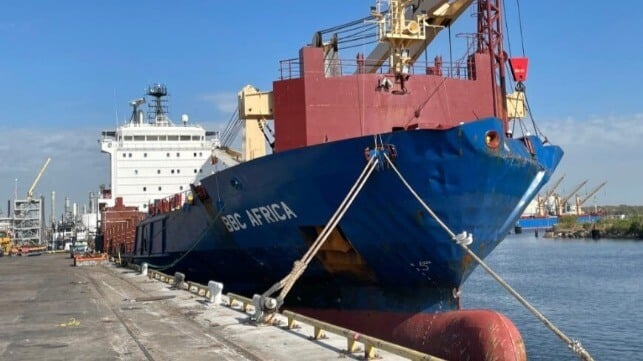NTSB: Delayed Emergency Response Contributed to Collision and $1M in Damage

The National Transportation Safety Board is out with a new warning for crews about testing and training to respond to a loss of steering control due to a malfunction. It concluded in an investigation into a 2023 collision in the Houston Ship Channel that the failure of a small rubber sheath and a delayed response by the crew to implement emergency steering procedures contributed to the collision after a component failed in the primary steering system.
The multi-purpose carrier BBC Africa (7,530 dwt) was departing Houston, Texas, on August 25, 2023, when the vessel suddenly lost steering control and veered off course, striking the docked bulker Common Faith (57,000 dwt), which was at the Anderson Grain Terminal in Houston. The post ballast tank of the bulker was punctured, along with damage to the shell plating, which cost a total of $467,000 to repair. The BBC Africa suffered damage to its bulbous bow, hull, and shell plating and forward bulwarks, costing $700,000 to repair. There were no injuries or pollution reported from the incident.
NTSB reconstructed the events using AIS data and crew interviews. The BBC Africa’s Voyage Data Recorder (VDR) was not functioning, but the vessel had permission to sail while repairs were being arranged.
On the morning of August 25, pre-departure testing of the system on the BBC Africa showed no problems. The second officer tested the steering gear, checked rudder movements, and ran the steering gear pumps, while engineers also completed a pre-departure checklist. The master also tested steering from the port bridge wing and told the pilot aboard that everything was “in good working order.”
About 10 minutes after having gotten underway, the ship was making speeds up to 6.8 knots, and everything was going smoothly. The pilot released the escort tug, and the pilot and master ordered that maneuvering control (bow thruster, main propulsion engine control, and steering) be transferred from the port bridge wing to the main control station on the bridge. The chief officer pressed the button to activate the controls on the bridge.
The pilot then gave a command for starboard 10, and the helmsman confirmed adjusting the rudder. Sensing the vessel was not turning at the expected rate, the pilot ordered starboard 20 and then hard to starboard. It was then that the chief officer realized the indicator light on the main control station had gone off and tried pressing it several times to reengage the controls.
The rudder indicator was showing a hard port position of 30 degrees. The master then switched the vessel’s steering to emergency override mode and got the rudder back to 30 degrees starboard. The pilot also ordered full astern, and the master then put the bow thruster to 100 percent starboard thrust. However, it was too late, and they hit the docked bulker.
Investigators were unable to replicate the failure, but working with the system manufacturer determined that a component failure had caused the system to fail. The company’s investigation found the rubber on the joystick (tiller) had invisible cracks that let moisture into the control unit, which contributed to the loss of the electrical signal.
The shipping company, on advice from the manufacturer, changed the bridge wing steering control tillers, the “in command” push buttons, and the main power supply transformer. They made the same changes on two other vessels with similar control systems.
The report says that the primary cause was the equipment failure. However, they also noted a stressful situation with short reaction time due to the vessel being in the confines of the port. The NTSB notes the crew had gone through training and regular drills, but recommended further training, saying that the delayed response from the ship’s crew to implement the emergency steering procedure from the bridge contributed to the vessel striking the docked bulker.
The steering gear manufacturer also issued a safety bulletin. It highlighted incidents with systems manufactured between 2002 and 2009, noting that they had malfunctioned due to a weakness with the protective rubber and the micro switches. The bulletin said the consequence of the failing micro switches could lead to unintended rudder movement.
